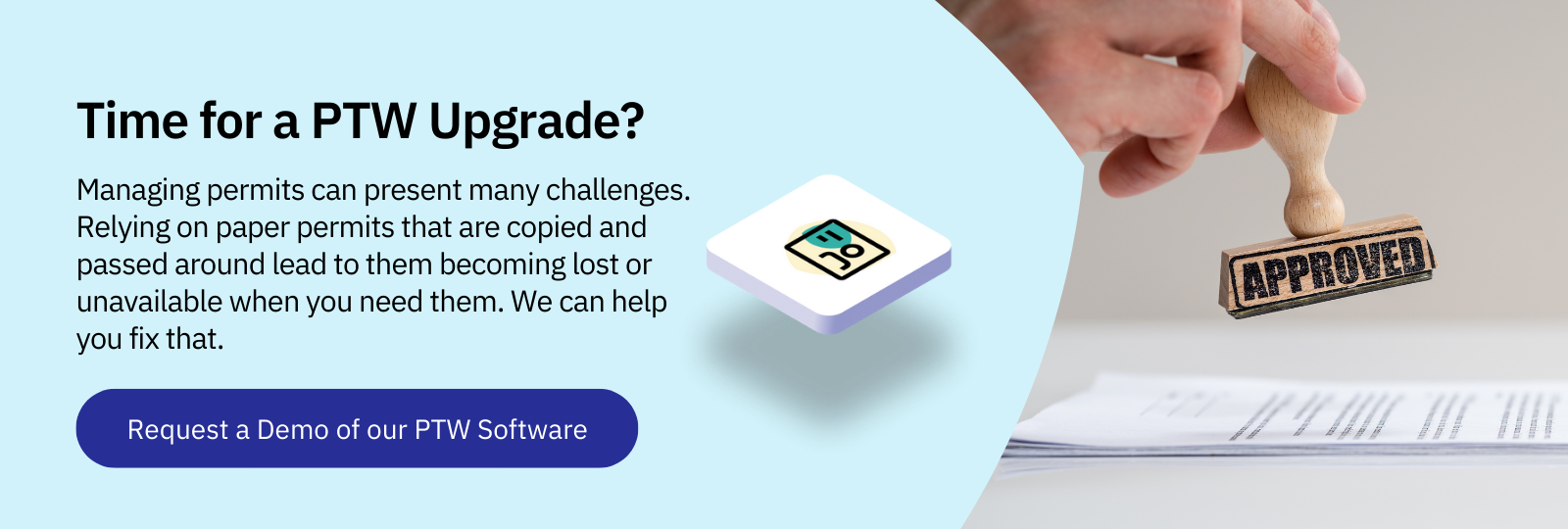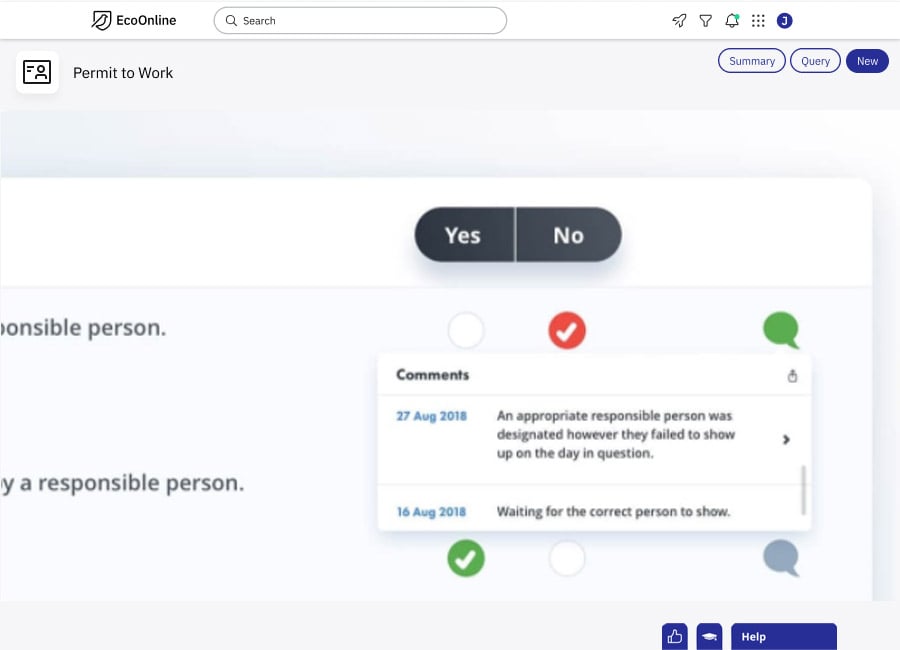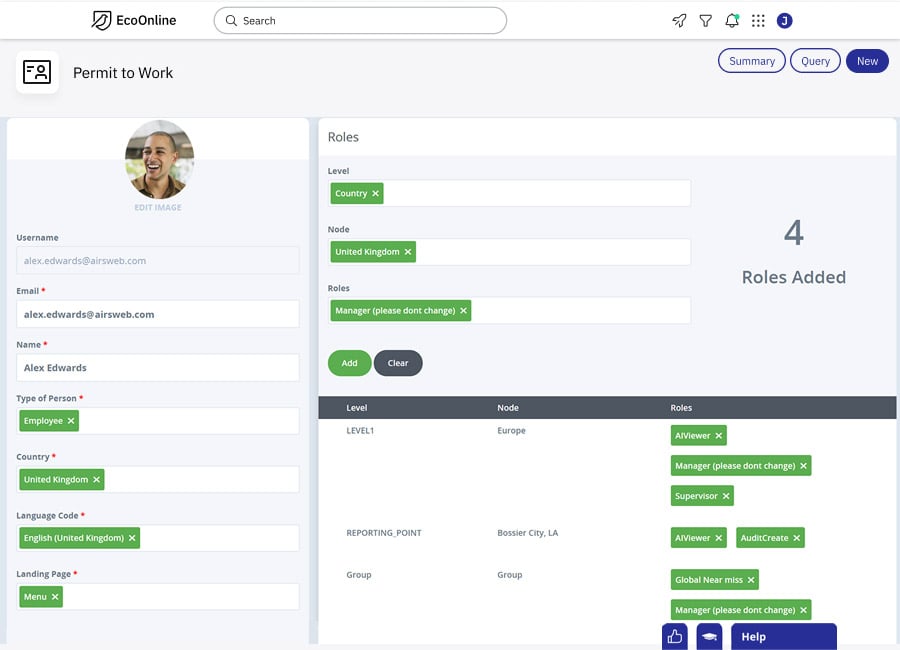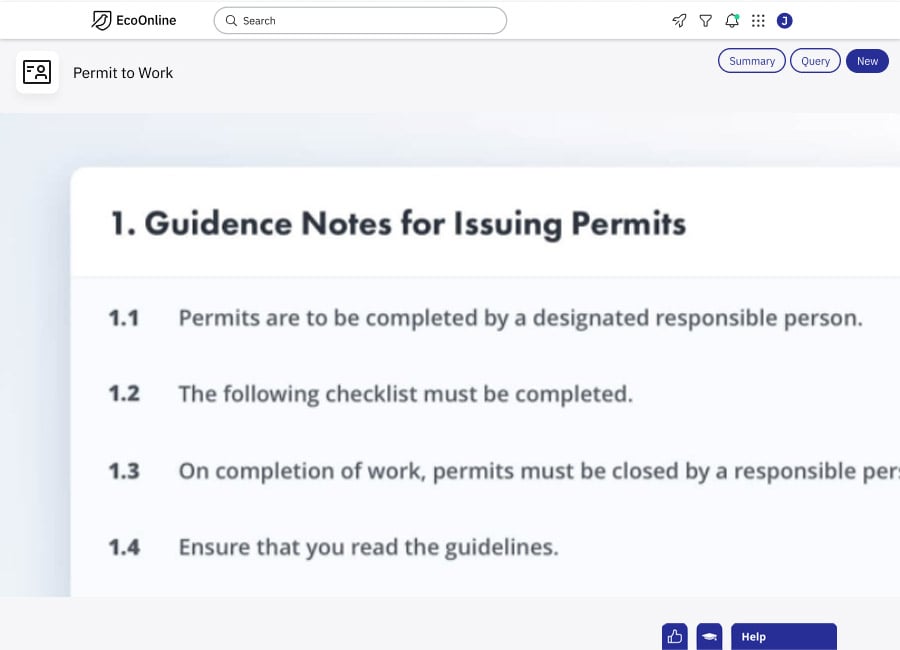The Ultimate Guide to Permit To Work Management
We have put together the ultimate guide for companies looking to improve the way in which they manage their permit-to-work process with user-friendly & customisable software.
Your journey towards a safer workplace starts with a chat.
.png?width=900&height=650&name=Permit%20to%20Work%20Guide%20(1).png)
A permit to work allows companies to authorize work in hazardous environments. Many companies often issue several permits to work in different areas, which is why it's important to have processes in place for managing permits to work.
One of the best ways to streamline permit to work management is by using a permit to work software. In this guide, we're going to discuss permit to work management in detail, including guidelines, authorized parties, and the best software to use.
What is the definition of Permit to Work in Health and Safety?
A permit to work (PTW) is a documented management system to ensure work is done safely and efficiently. It's mostly used in hazardous industries, though companies generally issue permits to work when hazardous work must be taken in any industry.
Why would you need a Permit to Work system?
A permit to work involves procedures that authorise certain people to carry out specific work within a specified time frame. It sets out the precautions required to complete the work safely, based on a HSE risk assessment and is therefore a core element of safe systems of work.
The permit-to-work form is a written and signed statement resulting from the work safety procedure, ensuring both the establishment of safe conditions for work to commence and the maintenance of safe conditions for the duration of the work, including the provision of emergency arrangements. It's generally considered a safe system of work for the job task, which prevents instructions from being missed and/or misinterpretation of instructions.
Permit to work forms can also serve as a checklist and a training document to ensure that all hazards, protective measures, work instructions and general requirements have been reviewed and understood by the assigned workers.
What is a permit to work used for?
A permit to work is used to identify the work to be completed in the following areas:
- What will be done and how it will be done(method statement/work procedure)
- The hazards involved
- The preparation necessary
- The precautions or protective measures to be taken
- The work procedures
- Authorise certain people to carry out specific work within a specified timeframe
- Declarations from the people authorising the work, carrying out the work and all involved in the work task/project
- A declaration from the permit originator that work has been completed or the equipment/machinery etc. being worked on is ready for normal use
A permit to work is generally a collaborative effort, ensuring that competent individuals have analysed the foreseeable risks and have outlined suitable precautions. The issue of a permit does not, by itself, make a job safe. Other precautions may need to be taken – e.g. electrical isolation, access barriers. Those who are trained and responsible must follow the instructions correctly.
Why is a Permit to Work deemed important?
The purpose is to make high risk job tasks in the workplace safer to conduct. For example, certain activities in the construction sector, such as hot works, excavation, or working in confined spaces all carry an elevated risk. As a result, a permit to work is required before the authorised individual is allowed to begin. To prevent incidents, it is vital that there be effective management of hazards to include safe systems of work.
Permit-to-work systems are a vital part of effective hazard management and are an integral part of a safe system of work. The aim of the permit to work system is to ensure that the task is carried out in accordance with the carefully considered conditions specified in a permit drawn up and independently verified by competent individuals.
What issues may contribute towards a major accident or hazard?
- Failure of the site safety management system
- Failure to recognise a hazard before and during a job task
- Failure to comply with the work permit system in hazardous environments
- Communication failure during the use of a work permit system
A permit to work system is often used for hazardous jobs, such as working in confined spaces or handling hot substances. Because of the necessary nature of such jobs, it's important for companies to ensure that all relevant steps are taken to eliminate the risks, or bring them within an acceptable threshold.
What is the duration of a Permit to Work?
The duration of a permit to work is not specified and is unique to the job task or the project in hand. The duration will be agreed by those involved in the preparation of the permit and the permit method statement. In most cases, hot permits to work are limited to 30 days, but this is only a guideline.
Permits to work are important as they ensure that all parties are aware of the risks, especially employees who will work on the job. It's also important that they know the steps taken by the authorities to reduce the risks, and understand any emergency procedures.
Who can issue a Permit to Work?
Permits should be issued, checked, and signed off by someone who is competent to do so, and who is not involved in undertaking the work.
.png?width=758&name=Screenshot%20(62).png)
What is a Permit to Work procedure method?
A permit to work procedure is a means of achieving effective control of a system of work through formal written documentation known as a permit to work form. The essential components of a permit-to-work system include:
- A written procedure (Safety Procedure/Work Instruction), setting out how the system/job is to operate and clearly defining who may authorise jobs and who is responsible for specifying and implementing the necessary precautions
- A permit to work form that outlines all guidelines and includes information about the authorising party and the individual(s) carrying out the job
- A method of informing the persons carrying out the work of the exact identity, location, nature and duration of the job, the hazards involved and the precautions to be taken
- A system for ensuring the safe hand-back of the workplace after the job is completed and, in the case of confined space entry, after the space is vacated (HSA, 2020).
The safety procedure must:
1. Clearly identify the kinds of jobs that require permits to work
2. Explain how the permit system works, for example:
- When to apply for a permit (how many hours before the work is started?)
- Where to get a permit?
- How to fill it out?
- How many copies are needed?
- Who gets copies?
- Who must be informed of the work?
- What to do with the permit when work is stopped or completed?
3. Define responsibilities, for example:
- Who fills out the form?
- Who identifies hazards?
- Who ensures precautions have been taken?
- Who issues/revokes permits?
- Who supervises the work?
- Who ensures work is completed (must be authorised and agreed before job task is commenced)?
Permit to Work Hazards
A permit to work should be used when there is danger from any of the following hazards:
- Fire
- Sparks from open flames, welding, cutting, furnaces, etc.
- Explosive, corrosive, or toxic gases or atmospheres
- Pressure systems
- Steam or other hot materials (burns)
- Electricity and other energy sources
- Accidental start-up of mechanical equipment
- Oxygen deficiency or oxygen enrichment
- Suffocation or drowning (for example, in bulk material bins or solvent storage tanks)
- Restricted access, exit and movement
- Toxic substances
- Radioactive materials
- Lasers
- Temperature extremes
- Any other recognized serious safety or health hazard
What are the different types of Permit to Work?
The different types of permit include:
Hot Work Permits - issued for work that requires, involves, or results in heat generation that is sufficient to ignite gases, vapours, or dusts, and may post a fire hazard. Some examples are welding, flame cutting, and metal drilling.
Safety Permits - issued when work involves steam, water, air, or electricity. Safety permits are also needed when repair or maintenance work requires the locking out of energy sources.
Entry Permits - used when workers are required to enter and work in confined spaces such as silos (manufacturing of cereals), tanks or pits. This type of permit is often combined with the other permits listed here, depending upon the nature of the work to be carried out in the confined space.
Unique Permits - issued when work involves hazardous conditions such as working near radioactive materials, working at heights, or carrying out other specialized work.
General Permits - issued for highly hazardous jobs of a more general nature that are not covered by any of the permits described above.
Permit to Work Guidelines
For the permit to work to achieve its aims and fulfil its purpose, it needs to cover all the legal requirements and essential points, control the risk sufficiently and clearly set out the procedures in place. Here are some guidelines to follow:
- The permit to work should be displayed at the job site
- A copy to be kept with the issuing authority
- Communicate your Policy and Work Procedures
- Provide Training
- General Information to Include in Your Work Permit:
- Permit title
- Permit reference number
- Job Location
- Plant Identification
- Description of work to be done and its limitations
- Hazard identification
- Precautions necessary and action in the event of an emergency – people who carried out precautions.
- Protective equipment
- Issue – signature (issuing authority) confirming that precautions have been taken and any isolations have been made. Date, time and duration of the permit.
- Acceptance – signature(S) confirming understanding of work to be done, hazards involved, and precautions required. Also confirming that permit information has been explained to all permit users.
- Extension/shift handover procedures – signatures confirming checks made that plant remains safe to be worked on and new authorities and permit users are made fully aware of the hazards and the precautions. A new expiry time is given.
- Hand back – signed by performing authority to certify that the work is completed. Signed by issuing authority to certify the work is completed and plant is ready for testing and recommissioning.
- Cancellation – certifying work tested and plant successfully recommissioned.
EcoOnline Permit-To-Work Software
The EcoOnline Permit to Work Software solution streamlines your permit management process, collecting all employee and contractor permit-related data in one central location.
One Secure Location
- Store all permit data in a central, easily accessible location
- Increase productivity by reducing time spent on manual or outdated systems
- Create all types of work permits with pre-designed templates or generate your own configurable templates
Greater Overview Of The Permit Process
- Easily standardise work permit processes, day-to-day management and contractor safety on-site
- Take control over permit issuance and approval, whether it's to employees or contractors
- Create, revoke and extend permits as necessary IA's can review and reject permits at any stage of the process

Effective Contractor Approval
- Manage and monitor all contractors and high-risk procedures in your organisation.
- Update hired contractors work permits directly, without the need for separate logins, permissions or access.
- Contractors can confirm and update their own work permit documentation according to your outlined process.

Minimise risk. Your journey towards a safer workplace starts with a chat.
When you speak with one of our in-house EHS experts, you get to see exactly how our software can work within your current processes to help your organisation grow a positive safety culture.
Digitize your PTW management

Trusted by 10,000+ customers worldwide
With the knowledge from 90 different industries we have developed our platform to make sure it tailors to your needs.
Don't take our word for it.





.png?width=1600&height=540&name=Banner%20(1600%20%C3%97%20540px).png)
